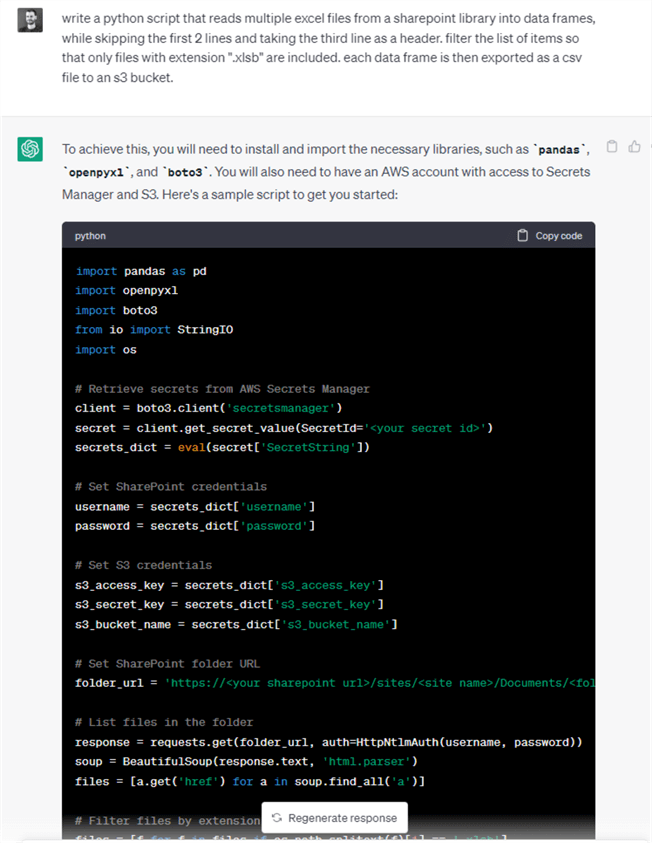By: Koen Verbeeck | Updated: 2023-05-22 | Comments | Related: More > Artificial Intelligence
Problem
The rise of a new generation of artificial intelligence (AI) tools has constantly been on the news lately. The ability to generate images, text, and even video by entering some text description seems bewildering. Some applications seem like a nice gimmick, but can any of those tools be helpful in our day-to-day lives as IT professionals?
Solution
In case you haven't read any news in the past months, AI tools are getting a lot of hype. Services like ChatGPT can seemingly generate any kind of text, and dall-e can generate multiple images from a text prompt. When you're reading this article, possibly a dozen or more AI services have been launched, and all of them will probably be able to achieve something that wasn't thought of before. Generate a full PowerPoint presentation from a summary of text. Analyze log data and tell if you have been hacked. The possibilities seem to be endless.
But how can AI assist IT professionals? How can it improve our daily (work) lives? Let's ask AI itself. The following screenshot comes from an interaction with ChatGPT:

It's important to realize that tools like ChatGPT and other large language models (LLM) are not always accurate. They can be thought of as "fancy auto-complete." In the training of the model, many different texts have been scanned. When you interact with it, it will generate text based on your keywords and what words are mathematically/statistically likely to come next. It doesn't know if it is correct or not. It's not a sentient being; it's not a calculator. It can get things wildly wrong (also known as "hallucinating"). I've seen LinkedIn posts where people joke about how ChatGPT couldn't solve a math problem. Sure, because it's not built to solve math problems. It's built to generate text. Or you see people making claims that "it cannot write SQL accurately" (although often the generated SQL is pretty decent). Again, this is not the immediate purpose of the tool. It would be the same as a junior developer only giving access to StackOverflow, letting them read a lot of answers about SQL, and then expecting them to write accurate SQL statements every time.
How Can AI Help You?
Research and Writing Code
As mentioned earlier, you can ask questions to an AI model, but you may not always get a 100% accurate answer (which, in reality, is the same on forums where any human can post an answer). However, specific tools are available to assist you when you write code. The most famous one is probably Github Copilot.

Github Copilot will analyze the code you've already written (along with other code snippets in your repository). When you, for example, type "function callRESTAPI", it will add lines for you in the current language that will do a standard REST API call. It's a very fancy auto-complete and can speed up your development work. As usual, it's up to you as the programmer to review the code to ensure it does what you want.
If you don't have Github Copilot, you can also ask services like ChatGPT to write your code. For example, I needed a Python script that downloads an Excel file from a SharePoint document library (getting the secrets from a secure vault such as Azure Keyvault), converts it to CSV, and writes the result to blob storage. The resulting script was about 90% correct. It didn't replace my job, but it made me much more efficient; I quickly got a working structure I could start from instead of writing everything from scratch. I don't write Python often, so this would have involved a lot of research.

On the other hand, an AI model can help you with debugging existing code. The Python package, ChatGPT Debugger, is a good example of this use case.
To help you better search, Microsoft has implemented AI features in the revamped Bing search engine.

Bing can include actual search references in the generated response.

Generating Text
In this tip, you've already seen multiple examples of how AI can generate text. Aside from code, AI can also help you with other text forms. For instance, you need to write a small piece for the company website. Instead of the technical terms you're used to, you now need to write in a more "marketing style," which is out of your comfort zone. You can ask an AI model to write a text based on your input. I definitely do not recommend copy-pasting the generated response. Like with code, you can take the generated text as a starting point and adjust where necessary. You still need to add images, double-check that everything is accurate, reword some phrases to match the desired result better, and add references (recommended).

An example of text that needs to be adjusted in the screenshot above is "integration with other Microsoft technologies, such as Excel, SharePoint, and Power BI." Personally, I would leave Power BI in the list; however, I'm not sure if I want to emphasize Excel and SharePoint here.
Or do you need to write an e-mail but are short on time? Let the AI model handle it.

If you think this all sounds futuristic, Microsoft has already announced the integration of Copilot in the Microsoft 365 suite: Introducing Microsoft 365 Copilot – your copilot for work.
Generating Images
The ability of AI models to quickly generate (fairly) accurate images (and video, too, nowadays) is what started the whole AI hype in the first place. IT professionals typically don't need images that often, but suppose you need to create a team presentation but can't find the right stock image. With services like DALL·E 2, you can create images based on a text prompt. The following images were created with Bing Image Creator (which uses DALL-E):

Another tool is Microsoft Designer – in preview when writing this tip – that can create attractive designs. Maybe for your website or blog? The following designs were created for the prompt "a blog post header for a story about the superpower of databases."

It's important to note that some AI image models have trouble with text, although Microsoft Designer doesn't seem to have this issue. The following image was created with Bing Image Creator. The prompt asked to put the text "star schema all the things" around a yelling star (read this blog post for more info on why I wanted this design).

Scanning Text
AI models also shine in a part where humans are quite slow: scanning large amounts of data. There are example services available where you can automatically summarize a text. In the following screenshot, I used Quillbot to summarize a paragraph from the beginning of this tip:

Log analytics tools can scan your log data and use machine learning algorithms to detect vulnerabilities or even breaches. The article, Online Log Data Analysis With Efficient Machine Learning: A Review, gives some ideas on how to use this. At the rate AI tools are becoming more sophisticated, we can expect to see some real advances in this area.
Assist in Your Soft Skills
Some AI tools can assist you with tasks that might not always be in the IT Professional's comfort zone. For example, you have to design a presentation around Azure Data Explorer, but maybe you don't have the time right now to put lots of effort into PowerPoint or lack design skills. You can ask an AI tool, such as Simplified, to create a presentation for you (although it seems the option to export it as a .pptx file is missing). The following slide was one of 10 slides created with the prompt "azure data explorer in the theme of Indiana Jones":

Another great AI application is the brand new website, goblin.tools. One of their main features is a magic to-do list. You give the site a task you need to do, and it will automatically split it up into subtasks:

You can click any subtask and let the AI split it further. Or do you need to write a tough professional email? You can ask ChatGPT or one of the many online email writing tools to create a draft for you.
AutoGPT takes it one step further and connects to the Internet, becoming a true virtual assistant. You can give it a set of tasks and perhaps some of your login information, such as your Amazon account. If it needs to order something from the store to finish a task, it can do it automatically for you. It can even execute Python scripts. (Use at your own risk).
Conclusion
Artificial Intelligence is on the rise, and it seems there's no stopping the tidal wave of new tools and features that will assist us in our daily lives. Everything mentioned in this tip only scratches the surface of what is possible right now. When it is published, it's probably already out-of-date since everything is evolving so quickly.
AI can be a blessing and a curse. It's up to you to figure out how to let it assist you professionally. But as mentioned several times, you may want to verify the results.
Next Steps
- If you have any thoughts or comments, let us know in the comments!
- An interesting NY Times article on how ChatGPT works.
- Microsoft also invests heavily in OpenAI and has already embedded some of the functionality in their products. Learn more about their LLM models in the documentation.
About the author
 Koen Verbeeck is a seasoned business intelligence consultant at AE. He has over a decade of experience with the Microsoft Data Platform in numerous industries. He holds several certifications and is a prolific writer contributing content about SSIS, ADF, SSAS, SSRS, MDS, Power BI, Snowflake and Azure services. He has spoken at PASS, SQLBits, dataMinds Connect and delivers webinars on MSSQLTips.com. Koen has been awarded the Microsoft MVP data platform award for many years.
Koen Verbeeck is a seasoned business intelligence consultant at AE. He has over a decade of experience with the Microsoft Data Platform in numerous industries. He holds several certifications and is a prolific writer contributing content about SSIS, ADF, SSAS, SSRS, MDS, Power BI, Snowflake and Azure services. He has spoken at PASS, SQLBits, dataMinds Connect and delivers webinars on MSSQLTips.com. Koen has been awarded the Microsoft MVP data platform award for many years.This author pledges the content of this article is based on professional experience and not AI generated.
View all my tips
Article Last Updated: 2023-05-22






